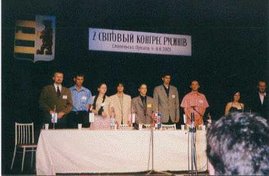 Paul Robert Magocsi, Chairman
Paul Robert Magocsi, ChairmanSighet, Romania, 22 June 2007
The delegation from North America represented in the World Congress comprises six organizations from the United States and Canada. These include the Carpatho-Rusyn Research Center in association with the Carpatho-Rusyn Society, the Carpathian Institute International, and the Rusin Association, all based in the United States, and the Rusyn Society of North America and World Academy of Rusyn Culture based in Canada.
Most of the activity carried out by these organizations during the past two years has focused on scholarly and cultural activity, lobbying work among foreign states and the United States government, and financial assistance to promote Rusyn culture and education in the European homeland. I shall provide here just a few words about the work of each of these organizations from the time of our last congress in 2005 until the present.
The newest of our organizations is the Carpathian Institute International headed by one of our delegates, Professor Paul Best, who organized an international scholarly conference in Przemyśl, Poland last spring, dealing with what he called the Fourth Rus’. The Institute also provided support for the publication of Father Dymytrii Sydor’s bi-lingual grammar of the Rusyn language. The Rusin Association of Minnesota sponsored a conference on the future of Rusyns as a community in the United States. The Rusyn Society of North America continued to sponsor social activity among the Vojvodinian Rusyn community in Canada, and through its chairman Julian Sabados (who is a delegate in the audience) it funded the publication of an English translation of a collection of poetry by Diura Papharhaï, the first laureate of the Dukhnovych Prize for Rusyn Literature.
The oldest existing Rusyn organization in North America is the Carpatho-Rusyn Research Center. It continues to distribute thousands of books and other published materials about Rusyns to individuals and institutions worldwide. Among these materials is the very popular brochure, Carpatho-Rusyns, which appeared in revised Slovak-language and Rusyn-language editions. Since the brochure first appeared in 1995, it has been published in nine languages (the most recent edition is in Czech) in a total 62,000 copies. The Carpatho-Rusyn Research Center also coordinates fund-raising for Rusyn-language schools in Ukraine and Slovakia, and it administers the annual Dukhnovych Prize for the best work in Rusyn literature.
In terms of individual membership, the largest organization in North America is the Carpatho-Rusyn Society, headed by John Righetti and its new vice-president Maryann Sivak, who for the first time is at the World Congress here, in Sighet. The Carpatho-Rusyn Society has nine branches throughout the United States. The Washington, D.C. branch of the Carpatho-Rusyn Society is headed by Victor Haburchak—also for the first time a delegate to the World Congress. The Washington branch has been especially active in lobbying the United States government and Congress on behalf of Rusyns in Europe, and it has organized meetings for the chairman of the World Congress of Rusyns with the embassies of eight countries and the European Union. The Carpatho-Rusyn Society is one of the three main contributors in support of Rusyn-language schools in Slovakia and Ukraine. It has also brought two folk ensembles from Slovakia for concert tours in the United States. The Carpatho-Rusyn Society continues to publish the New Rusyn Times (whose editor Richard Custer is a delegate with us today), but the society’s biggest concern is to raise funds to renovate the National Carpatho-Rusyn Cultural Center housed in the former Byzantine Catholic Cathedral in Munhall, Pennsylvania.
The World Academy of Rusyn Culture headed by Steven Chepa (one of our delegates at this congress) continues to be the largest financial supporter for Rusyn cultural and educational activity in the European homeland. The Academy supports Rusyn web-sites in North America and Slovakia, it provides an annual fellowship at the University of Toronto for scholars from Europe writing on Rusyn-related topics, and it funds two awards: the Dukhnovych Prize for Rusyn Literature, and the Chepa Award for Lifetime Achievement on Behalf of Rusyn Culture. Recently , the Steven Chepa Fund has been created at the University of Toronto; it has already provided funds for new textbooks and other materials for Rusyn-language classes, and has contributed funds to prepare for publication the two-volume Rusyn-Russian dictionary by Igor Kercha and the revised version of the Rusyn Orthographic Dictionary by Vasyl’ Iabur and Anna Plishkova.
The most ambitious project sponsored through the Steven Chepa Fund is the illustrated book, The People From Nowhere, published in a beautiful full-color format by V. Padiak in Uzhhorod. The book has already appeared in four editions: Ukrainian (2,000 copies), English (4,000 copies), Rusyn (5,500 copies), and Romanian (3,000 copies). Slovak-and Polish-language editions are in process. Aside from printing costs, the Chepa Fund has provided funds to distribute the book gratis to libraries, government institutions, and individuals in Ukraine, Slovakia, Poland, Hungary, and Romania. The People From Nowhere is not just another history book but rather emphasizes a very important conceptual point: that Rusyns are not a small minority living in one country, but that their homeland is Carpathian Rus’, a historic territory that includes Lemko Rus’ in Poland, Prešov Rus’ in Slovakia, Subcarpathian Rus’ in Ukraine, and Maramorosh Rus’ in Romania. From various parts of Carpathian Rus’ Rusyns emigrated and formed communities in the Vojvodina, the Czech Republic, and North America. School programs, in particular, need to be aware and promote this broader and more comprehensive understanding of Rusyn history and culture.
Rusyn organizations in North America cooperate and complement each other. They do not waste time fighting and denigrating each other. Together they will continue to do what they can to assist Rusyn culture, education, and scholarship in our common homeland, Carpathian Rus’.








No comments:
Post a Comment